
|
Astronomy Picture Of the Day (APOD)
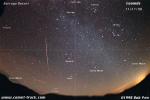 An Annotated Leonid
An Annotated Leonid
30.11.1998
The 1998 Leonids Meteor Shower was perhaps the most photographed meteor event in history. Patient observers saw bright meteors streak across dark skies every few minutes, frequently leaving fading trails stretching across the sky. High above the Anza-Borrego Desert, a meteor was photographed streaking up from the radiant constellation of the Leonids: Leo.
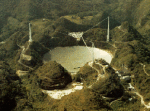 Arecibo: The Largest Telescope
Arecibo: The Largest Telescope
29.11.1998
The Arecibo radio telescope is currently the largest single-dish telescope in the world. First opening in 1963, this 305 meter (1000 foot) radio telescope resides in a natural valley of Puerto Rico. The Arecibo telescope has been used for many astronomical research projects, including
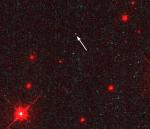 A Lonely Neutron Star
A Lonely Neutron Star
28.11.1998
How massive can a star get without imploding into a black hole? These limits are being tested by the discovery of a lone neutron star in space. Observations by the Hubble Space Telescope have...
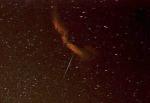 Twisting Meteor Train
Twisting Meteor Train
27.11.1998
Blazing through the sky at 70 kilometers per second, 100 kilometers or so above planet Earth, many bright Leonid meteors left behind a persistent, smoke-like trail of glowing, hot, ionized gas. Twisting in high altitude winds, these trails or trains typically were visible for many minutes.
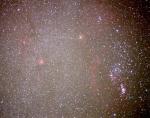 Meteor Milky Way
Meteor Milky Way
26.11.1998
The bold, bright star patterns of Orion (right) are a familiar sight to even casual skygazers. But this gorgeous color photo also features a subtler spectacle - the faint stars of the Milky Way.
 A Leonid Bolide Over Kansas
A Leonid Bolide Over Kansas
25.11.1998
The 1998 Leonid Meteor Shower featured many bright events. Extremely bright meteors, known as bolides or fireballs, can briefly glow brighter than the full moon. Pictured above is a Leonid bolide caught during a five-minute, wide-angle exposure. The bolide was so bright it lit up the surrounding area, making otherwise dark trees visible.
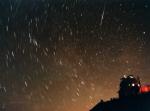 Seven Leonids Over Wise Observatory
Seven Leonids Over Wise Observatory
24.11.1998
More Leonids were visible at some places than others. In Israel, early in the morning of 17 November, it rained meteors though a clear sky. Observers there reported a peak rate for the 1998 Leonid Meteor Shower of about 600 meteors per hour.
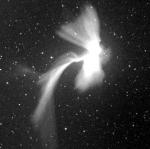 A Leonid Meteor Explodes
A Leonid Meteor Explodes
23.11.1998
Click on the above image and watch a Leonid meteor explode. The tremendous heat generated by the collision of a small sand-bit moving at 70 kilometers/second with the Earth's upper atmosphere causes the rock-fragment to heat up, glow brightly, and disintegrate.
 The High Energy Crab Nebula
The High Energy Crab Nebula
22.11.1998
This is the mess that is left when a star explodes. The Crab Nebula is so energetic that it glows in every kind of light known. Shown above are images of the Crab Nebula from visible light to the X-ray band.
 Catching Falling Stardust
Catching Falling Stardust
21.11.1998
This carrot shaped track is actually little more than 5 hundredths of an inch long. It is the trail of a meteroid through the high-tech substance aerogel exposed to space by the shuttle launched EURECA (European Recoverable Carrier) spacecraft.
|
January February March April May June July August September October November December |
||||||||||||||||||||||||||||||||||||||||||||||||||||||||